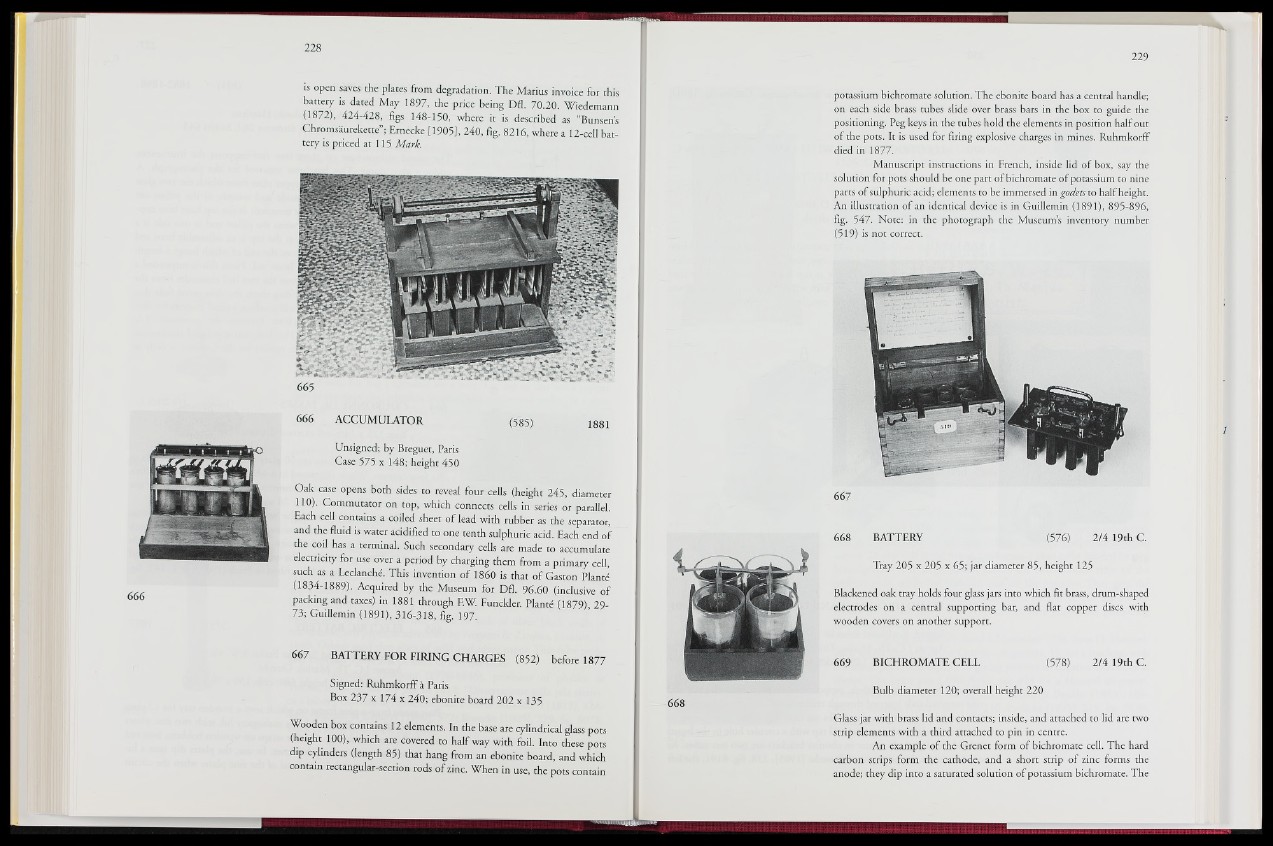
is open saves the plates from degradation. The Marius invoice for this
battery is dated May 1897, the price being DO. 70.20. Wiedemann
(1872), 424-428, figs 148-150, where it is described as “Bunsens
Chromsaurekette”; Ernecke [1905], 240, fig. 8216, where a 12-cell battery
is priced at 115 Mark.
666 ACCUMULATOR ($85) 1881
Unsigned; by Breguet, Paris
Case 575 x 148; height 450
Oak case opens both sides to reveal four cells (height 245, diameter
110). Commutator on top, which connects cells in •scries or parallel.
Each cell contains a coiled sheet of lead with rubber as the separator,
and the fluid is water acidified to one tenth sulphuric acid. F.arh. end of
the coil has a terminal. Such secondary cells are made to accumulate
electricity for use over a period by charging them from a primary cell,
such as a Leclanche. This invention of I860 is that of Gaston Plant#
(1834-1889). Acquired by the Museum for Dfl. 96.60 (inclusive; of
packing and taxes) in 1881 through F.W Funckler. Plante (1879), 29-
73; Guillemin (1891), 316-318, fig. 197.
667 BATTERY FOR FIRING CHARGES ‘(852) before 1877
Signed: Ruhmkorff a Paris
Box 237 x 174 X 240; ebonite board 202 x 135
Wooden box contains 12 elements. In the base are cylindrical glass pots
(height 100), which are covered to half way with foil. Into these pots
dip cylinders (length 85) that hang from an ebonite board, and which
contain rectangular-section rods of zinc. When in use, the pots contain
potassium bichromate solution. The ebonite board has a central handle;
on each side brass tubes slide over brass bars in the box to guide the
positioning. Peg keys in the tubes hold the elements in position half out
of the pots. It is used for firing explosive charges in mines. Ruhmkorff
died in 1877.
Manuscript instructions in French, inside lid of box, say the
solution for pots should be one part of bichromate of potassium to nine
parts of sulphuric acid; elements to be immersed in godets to half height.
An illustration of an identical device is in Guillemin (1891), 895-896,
fig. 547. Note: in the photograph the Museums inventory number
(519) is not correct.
667
668
668 BATTERY (576) 2/4 19th C.
Tray 205 x 205 x 65; jar diameter 85, height 125
Blackened oak tray holds four glass jars into which fit brass, drum-shaped
electrodes on a central supporting bar, and flat copper discs with
wooden covers on another support.
669 BICHROMATE CELL (578) 2/4 19th C.
Bulb diameter 120; overall height 220
Glass jar with brass lid and contacts; inside, and attached to lid are two
strip elements with a third attached to pin in centre.
An example of the Grenet form of bichromate cell. The hard
carbon strips form the cathode, and a short strip of zinc forms the
anode; they dip into a saturated solution of potassium bichromate. The